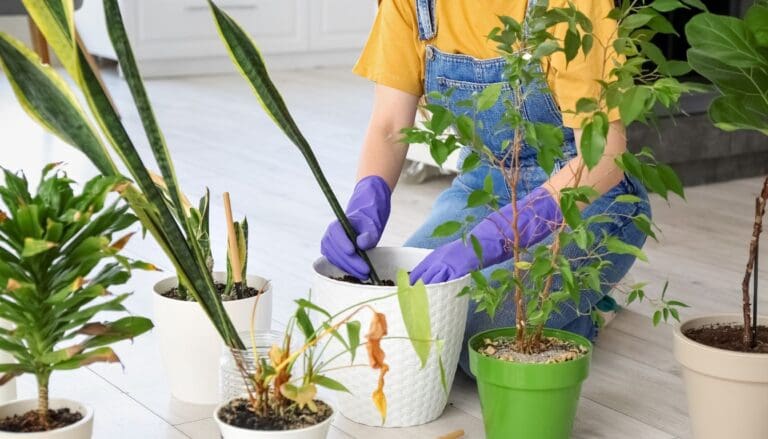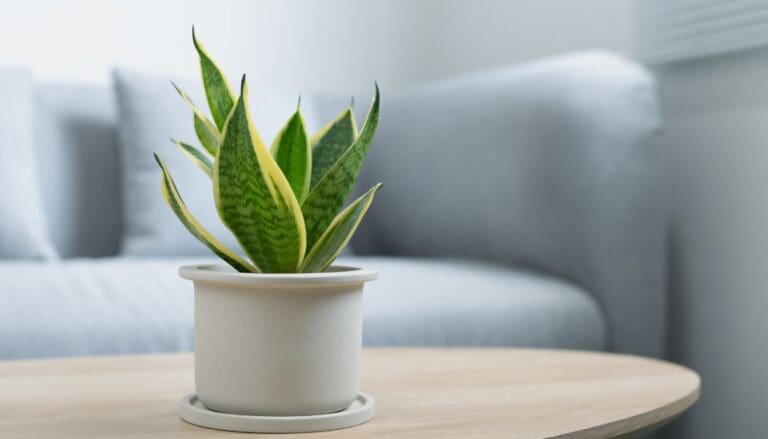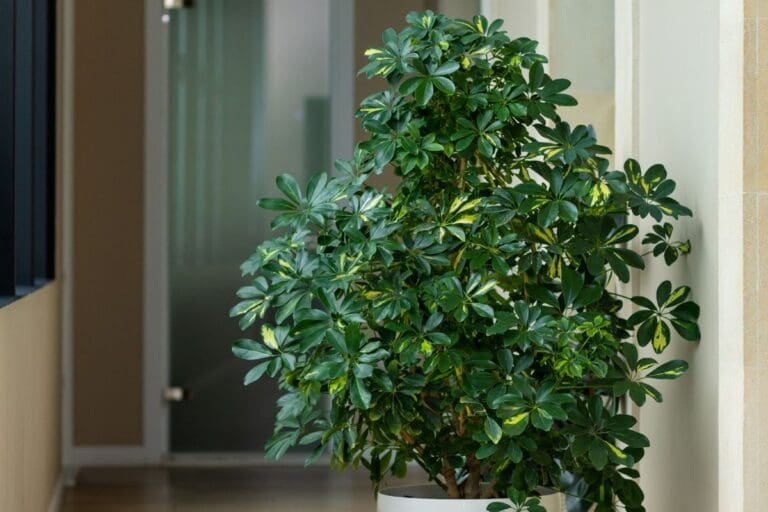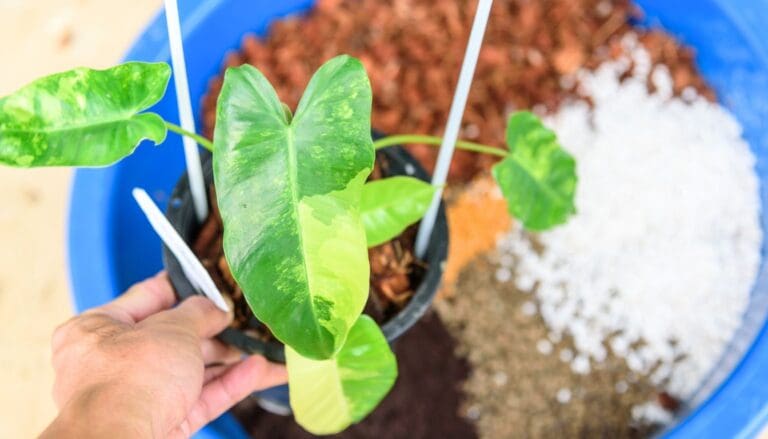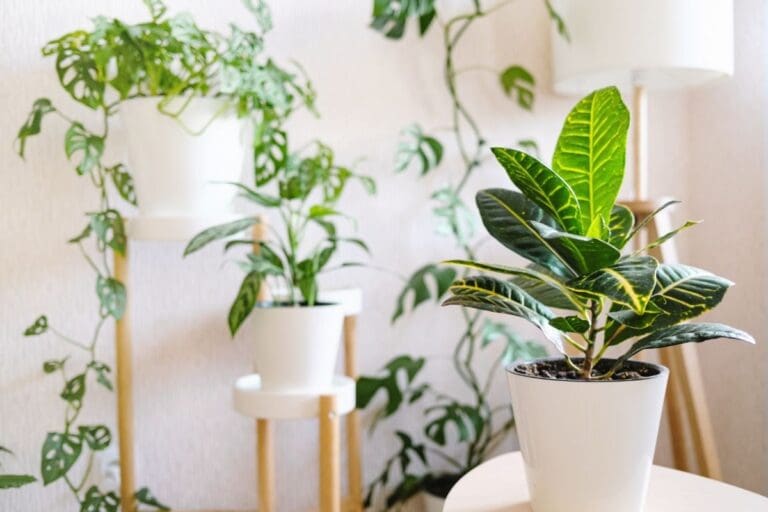Arrowhead Plant Light Needs: What Type, How Much & More
The Arrowhead plant, also called Syngonium, is a tropical plant that comes from the tropical rainforests of America. To keep your arrowhead plant thriving you must provide them with the right lighting conditions.
So, in this article, we shall learn all about the lighting requirements of the arrowhead plant.
In general, Arrowhead plants prefer bright indirect sunlight. While they can survive in low lighting conditions, direct sunlight is harmful. Some variegated arrowhead species can handle morning or evening sun, but you must protect them during the hottest part of the day.
In this article, you will know everything about the light requirements of arrowhead plants. We will discuss how much light it needs, what type of light is best suited for it, and many more.

Please note: Simplify Plants is reader-supported. Some links in the post are affiliate links and I get a commission from purchases made through links in the post.
Importance of light for arrowhead plant
Light is the primary source of energy for all plants.
In their natural habitat, plants get all the light they need, but when you bring them inside the house, you must ensure that they get enough light.
Like all other plants, Arrowhead plants photosynthesize with the help of light to produce energy and food.
Therefore, without enough light, the rate of photosynthesis will reduce along with all the other activities of the plant.
This will stop or reduce the growth of your arrowhead plant and bring other problems as well.
What type of light does an arrowhead plant need?
Arrowhead plants belong to the tropical forests of Central and South America, where they grow under dappled sunlight.
Arrowhead plants do best under dappled sunlight or indirect bright light as houseplants.
If you have a more variegated species, it will require bright indirect light whereas, a less variegated species or one with entire green leaves will do well even with average indirect light.
If your house doesn’t get enough light, your arrowhead plant might adjust to the low light conditions.
However, slow growth or droopy leaves are signs of plants growing in low light.
If you notice these on your arrowhead plant, you need to understand that the plant is not happy with the low-light condition.
But you must always protect your arrowhead plant from direct intense sunlight.
Direct vs. Indirect light
Let us first understand the difference between direct and indirect sunlight, as you will read these terms quite a few times in this article.
Light is distinguished into two types – direct and indirect.
Direct light is when your plant is exposed to the sun’s direct rays without any filter in between.
The plant is also exposed to the sun’s intense heat in this condition.
When you take your hand between the light and the plant, you notice a distinguished shadow and feel the heat.
In the case of indirect light, there is some filter in between the light and the plant, or the plant is placed at a spot away from the direct rays of the Sun.
A plant near a window covered by a sheer curtain receives indirect light.
If you place your hand between the plant and such light, you will notice a much softer shadow and not feel much heat.
Can an arrowhead plant survive without light?

An arrowhead plant might survive in low-light conditions for a while, but it will not survive without light.
Plants are meant to grow in an environment where they will receive light during the day.
They photosynthesize and produce energy with the help of light, and without light, your arrowhead plant will fail to photosynthesize at all.
So not providing any light will only bring their end.
Best spot for Arrowhead plants
The arrowhead is a versatile plant that can handle different lighting conditions.
While deciding the ideal spot for arrowhead plants, make sure it gets bright to moderately low light there.
However, you cannot keep the arrowhead plant in low light conditions for too long as a plant will not react well to it and show signs of problems.
Avoid keeping your arrowhead plant in very low light areas such as corners of the rooms for offices.
Instead, you can keep the arrowhead plant near any window.
Arrowhead plants can do well in east or west-facing windows, but you must use a filter to protect them from direct sunlight.
You can also keep the plant 5-6 feet away from the window.
South-facing windows provide the most light throughout the day, so you can keep your arrowhead plant near a south-facing window by maintaining a distance of 5-6 feet.
Is my Arrowhead plant getting enough light?

Although many people suggest that Arrowhead plants adjust well to low-light conditions, they start facing problems after a certain period.
Arrowhead plants can tolerate low lighting for a short period, but they won’t tolerate long spans of low light.
So, if your arrowhead plant is not receiving enough light, you will notice a few signs on them.
Some of these signs might be:
- Droopy leaves: Without enough light, the plant fails to produce enough energy, due to which the leaves don’t have the energy to remain upright and droop.
- Falling leaves: If you keep the plant in low light for too long, the leaves start falling due to a lack of energy.
- Root rot: Without enough light, the soil will take longer to get dry, and the roots will remain wet. This will lead to root rot if you fail to spot the signs.
- Leggy growth: If the plant doesn’t get enough light and energy, the stems will grow very long, with very few leaves on them.
- Leaning stem: The stems also start stretching in search of light, due to which they might lean on one side instead of standing upright.
- Stunted growth: All these affect the plant’s growth, and you might not notice any growth on your Arrowhead plant.
Inspect the Arrowhead plant thoroughly and shift it to a brighter spot if you notice these signs.
Is my arrowhead plant getting too much sun?

Arrowhead plants thrive in bright indirect sunlight, but they cannot tolerate direct intense sunlight.
If your arrowhead plant receives direct sunlight or gets too much sun, you will notice the following signs:
- Yellow leaves: Yellow leaves can be caused due to various reasons, one of which is direct or too much sunlight.
- Dry leaves: Too much sunlight robs the leaves’ moisture and leaves them dry. These leaves eventually fall off.
- Brown crispy spots on leaves: Due to loss of moisture and sunburn, the leaf develops brown and dry spots, affecting the entire leaf.
- Dry soil: Too much sun not only affects the leaves but also sucks out all the moisture from the soil.
If you come across these signs, shift your arrowhead plant to a different spot where it will not get direct sunlight.
If you placed your arrowhead plant on the window sill or very close to the window, move it 5-6 feet away from the window.
You use also use a filter to protect it from the intense sunlight.
Are arrowhead plants low light?
Whether an arrowhead plant will grow in a low-light condition depends on the species.
If you have a variegated variety, it will require more light than a greener one.
However, growing arrowhead varieties in low light will result in slow growth and other problems that I mentioned earlier.
Since arrowhead plants can tolerate short spans of low-light conditions, you can place it in a low-light spot for 1-2 weeks and move it back to a brighter spot.
However, you can use artificial lights instead of keeping the arrowhead plant in a low-light area.
Many artificial lights are available for plants in the market called grow lights.
Use these lights to provide sufficient light to your arrowhead plant.
How many hours of sunlight do arrowhead plants need?

Arrowhead plants require at least 8 hours of bright indirect sunlight every day.
Try to place it in the brightest location of your house to provide it with the best lighting conditions.
If the plant gets good bright light only for a few hours, use artificial lights to provide enough light to complete the remaining hours.
How to provide sufficient light to arrowhead plants?
To sum it up, use these steps to provide the right lighting condition to your arrowhead plant.
- First and foremost, keep your arrowhead plant away from the direct sunlight as it causes sunburn.
- Avoid placing the arrowhead plant on window sills.
- If you place the arrowhead plant near a window, keep a 5-6 feet distance.
- Use a sheer curtain to filter the direct sunlight for your arrowhead plant.
- If you don’t get enough natural light in the house, use artificial lights to provide sufficient light to the arrowhead plant.
- If you notice signs like stunted growth or droopy leaves, your plant might not be receiving enough light, so you must move it to a brighter spot.
- If you notice brown leaves or dry soil, move your arrowhead plant to a location with less intense light, as these are the signs of the plant getting too much light.
- If you want to keep your Syngonium outside, place it in a shaded spot protected from direct sunlight.
- In the winter, you can expose the plant to direct sunlight for a few hours.
Reference: CABI, Britannica, United States Department of Agriculture, Wikipedia, Children’s Health Queensland Hospital and Health Service, Missouri Botanical Garden.
Recommended Garden Supplies
| Product Image | Our Recommended Gardening Supplies | Check Offers! |
|---|---|---|
Top Top
Top
Top
Top
Top
Top
Top
Top | rePotme Houseplant and Tropical Classic Potting Soil Mix | Check Offer On Amazon |
 Top
Top
Top
Top
Top
Top
Top
Top | Espoma Organic Indoor Plant Food | Check Offer On Amazon |
 Top
Top
Top
Top
Top
Top
Top
Top | GooingTop LED Grow Light 6000K Full Spectrum Clip Plant Growing Lamp | Check Offer On Amazon |
 Top
Top
Top
Top
Top
Top
Top
Top | Soil Moisture Meter | Check Offer On Amazon |
 Top
Top
Top
Top
Top
Top
Top
Top | Govee Hygrometer Thermometer, Bluetooth Enabled! | Check Offer On Amazon |
 Top
Top | LEVOIT Humidifiers for Large Room(Best For Plants) | Check Offer On Amazon |
 Top
Top
Top
Top
Top
Top
Top
Top | Upgraded DIY Automatic Drip Irrigation Kit, 15 Potted Houseplants Support | Check Offer On Amazon |
 Top
Top
Top
Top
Top
Top
Top
Top | Stainless Steel Heavy Duty Gardening Tool Set | Check Offer On Amazon |
 Top
Top
Top
Top
Top
Top
Top
Top | Bonide Insecticidal Soap | Check Offer On Amazon |
 Top
Top
Top
Top
Top
Top
Top
Top | Bonide 32 oz Spray Neem Oil for Organic Gardening | Check Offer On Amazon |
 Top
Top
Top
Top
Top
Top
Top
Top | Garden Safe Fungicide | Check Offer On Amazon |

